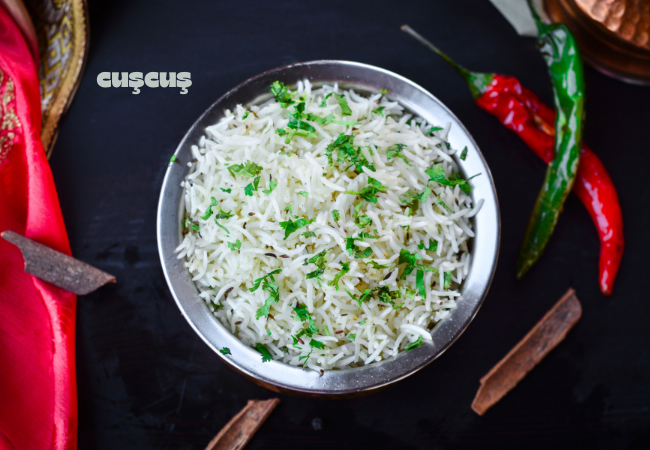History of Couscous
Origins
Cuşcuş has its roots in North Africa, where it has been a staple food for centuries. The Berbers, indigenous people of North Africa, are credited with developing couscous. The exact time of its creation is not clear, but evidence suggests that couscous was being prepared as early as the 9th century.
Cultural Significance
Cuşcuş is more than just food; it is a cultural symbol. In many North African countries, couscous is traditionally served during significant events and celebrations such as weddings, religious holidays, and family gatherings. It represents hospitality and community.
Spread Around the World
The spread of couscous beyond North Africa began with the movement of the Berbers and the influence of the Arab expansion. In the modern era, couscous has become popular worldwide, finding its place in various international cuisines and culinary practices.
What is cuşcuş?
Definition
Couscous is a type of pasta made from semolina wheat granules. It is known for its light, fluffy texture and quick cooking time.
Different Names
While “couscous” is the most common name, it is also known as “seksu” in Berber and “kuskus” in Turkish. The names and slight variations in preparation reflect its wide-reaching cultural impact.
Comparison with Similar Foods
Couscous is often compared to other grain-like foods such as rice and quinoa. Unlike these, couscous is not a grain but rather a form of pasta. It has a unique texture and flavor that sets it apart from its counterparts.
Types of Couscous
Moroccan Couscous
This is the smallest and most commonly available type of couscous. It cooks quickly and has a delicate texture.
Israeli (Pearl) Couscous
Also known as pearl couscous, it is larger and has a chewier texture compared to Moroccan couscous. It is often used in salads and pilafs.
Lebanese Couscous
The largest type, also known as Moghrabieh, is similar in size to small chickpeas and has a more robust, hearty texture.
Whole Wheat Couscous
Made from whole wheat flour, this variety offers more fiber and nutrients compared to regular couscous. It is a healthier option for those looking to increase their intake of whole grains.
Nutritional Benefits of Couscous
Macronutrients
Couscous is primarily composed of carbohydrates, providing a good source of energy. It is also low in fat and contains some protein.
Micronutrients
Couscous contains essential vitamins and minerals such as B vitamins, selenium, and manganese, contributing to various bodily functions and overall health.
Health Benefits
The nutritional profile of couscous supports heart health, aids in digestion, and can help in weight management due to its low calorie and high fiber content.
How to Cook Couscous
Basic Cooking Method
To prepare couscous, boil water or broth, remove from heat, and stir in couscous. Cover and let it sit for about five minutes before fluffing with a fork.
Steaming
Traditional steaming involves using a couscoussière, a special pot for steaming couscous, which enhances its texture and flavor.
Using a cuşcuş
A cuşcuş consists of a deep pot and a shallow pan with holes. The couscous is placed in the pan, allowing steam from the boiling water or broth below to cook it gently.
Microwave Method
For a quicker option, couscous can be prepared in the microwave by combining couscous and boiling water in a microwave-safe dish and microwaving for a few minutes.
Traditional cuşcuş Dishes
Moroccan Couscous
Typically served with a stew of meat and vegetables, Moroccan couscous is a flavorful and aromatic dish seasoned with spices like cumin, coriander, and saffron.
Tunisian Couscous
In Tunisia, couscous is often prepared with a spicy tomato-based sauce and a variety of meats such as lamb, chicken, or fish.
Algerian Couscous
Algerian couscous is known for its rich and diverse ingredients, including chickpeas, vegetables, and dried fruits, creating a sweet and savory combination.
Modern Couscous Recipes
Salads
Couscous salads are popular for their versatility and ease of preparation. Ingredients like fresh vegetables, herbs, and dressings can be mixed with couscous to create a refreshing dish.
Main Courses
Couscous can be the base for hearty main courses by adding proteins such as chicken, lamb, or tofu, along with vegetables and flavorful sauces.
Side Dishes
As a side dish, couscous pairs well with grilled meats, fish, or roasted vegetables, adding a light and fluffy texture to the meal.
Desserts
Couscous can also be used in desserts, often combined with honey, nuts, and dried fruits for a sweet and satisfying treat.
Couscous in Different Cuisines
Mediterranean
In Mediterranean cuisine, couscous is often used in salads and side dishes, highlighting fresh and vibrant ingredients like tomatoes, cucumbers, and olives.
Middle Eastern
Middle Eastern dishes incorporate couscous with aromatic spices, dried fruits, and nuts, creating rich and flavorful meals.
North African
North African cuisine features cuşcuş prominently in traditional dishes, often combined with a variety of meats, vegetables, and spices to create complex and hearty flavors.
Couscous and Vegetarian Diets
Plant-Based Recipes
Couscous is an excellent ingredient for vegetarian and vegan diets, providing a versatile base for plant-based meals rich in vegetables, legumes, and herbs.
Nutritional Benefits for Vegetarians
For vegetarians, couscous offers a source of plant-based protein and essential nutrients, making it a valuable addition to a balanced diet.
Couscous and Gluten-Free Diets
Gluten-Free Alternatives
While traditional couscous contains gluten, there are gluten-free alternatives available, such as those made from corn or rice.
Recipes
Gluten-free couscous can be used in a variety of recipes, offering similar textures and flavors to traditional couscous, allowing those with gluten intolerance to enjoy this versatile food.
Couscous and Weight Loss
Low-Calorie Recipes
Couscous can be part of a weight-loss diet due to its low-calorie content. Combining couscous with vegetables and lean proteins can create satisfying, low-calorie meals.
Portion Control Tips
To manage portions, measure cuşcuş before cooking and be mindful of additional ingredients such as oils and high-calorie dressings.
Storing and Preserving Couscous
Best Practices
Store uncooked couscous in an airtight container in a cool, dry place. Cooked couscous should be refrigerated and consumed within a few days.
Shelf Life
Uncooked couscous has a long shelf life when stored properly, while cooked couscous should be eaten within a few days for the best taste and texture.
Freezing Couscous
Cooked couscous can be frozen for longer storage. Place it in a freezer-safe container and thaw in the refrigerator before reheating.
Couscous in Restaurants
Popular Dishes
Many restaurants offer couscous dishes, often highlighting traditional or innovative recipes that showcase its versatility and flavor.
Restaurant Recommendations
Look for restaurants that specialize in Mediterranean, Middle Eastern, or North African cuisines to find authentic and delicious couscous dishes.
Couscous vs. Quinoa
Nutritional Comparison
Both couscous and quinoa offer nutritional benefits, but quinoa is a complete protein, providing all essential amino acids, while couscous is primarily a source of carbohydrates.
Cooking Differences
Couscous cooks quickly and easily, while quinoa requires a slightly longer cooking time and careful rinsing to remove its natural bitterness.
Taste and Texture
Couscous has a light, fluffy texture and mild flavor, making it versatile for many dishes, while quinoa has a slightly nutty taste and firmer texture.
Innovative Couscous Uses
Creative Recipes
Couscous can be used in creative ways, such as in stuffed vegetables, as a crust for baked dishes, or in unconventional salads.
Fusion Cuisine
In fusion cuisine, couscous can be combined with ingredients from various culinary traditions, creating unique and exciting dishes.
Leftover Ideas
Leftover couscous can be transformed into new meals, such as fritters, stir-fries, or even breakfast dishes with fruit and yogurt.
FAQs About Couscous
What is couscous made of? Couscous is made from semolina wheat granules that are steamed or soaked to create a light, fluffy texture.
Is couscous gluten-free? Traditional couscous is not gluten-free, but there are gluten-free alternatives available made from corn or rice.
How long does it take to cook couscous? Couscous typically cooks in about 5 minutes when using the basic method of soaking in hot water or broth.
Can couscous be used in desserts? Yes, couscous can be used in desserts by combining it with ingredients like honey, nuts, and dried fruits.
What are the health benefits of couscous? Couscous is low in fat, provides a good source of carbohydrates, and contains essential vitamins and minerals like selenium and B vitamins.
How should couscous be stored? Uncooked couscous should be stored in an airtight container in a cool, dry place, while cooked couscous should be refrigerated and consumed within a few days.
Conclusion
Couscous is a versatile and nutritious food that can be enjoyed in a variety of dishes, from traditional North African stews to modern salads and desserts. Its ease of preparation and adaptability to different flavors and ingredients make it a valuable addition to any kitchen. Whether you are looking for a quick side dish, a hearty main course, or a healthy option for weight management, couscous offers endless possibilities.




